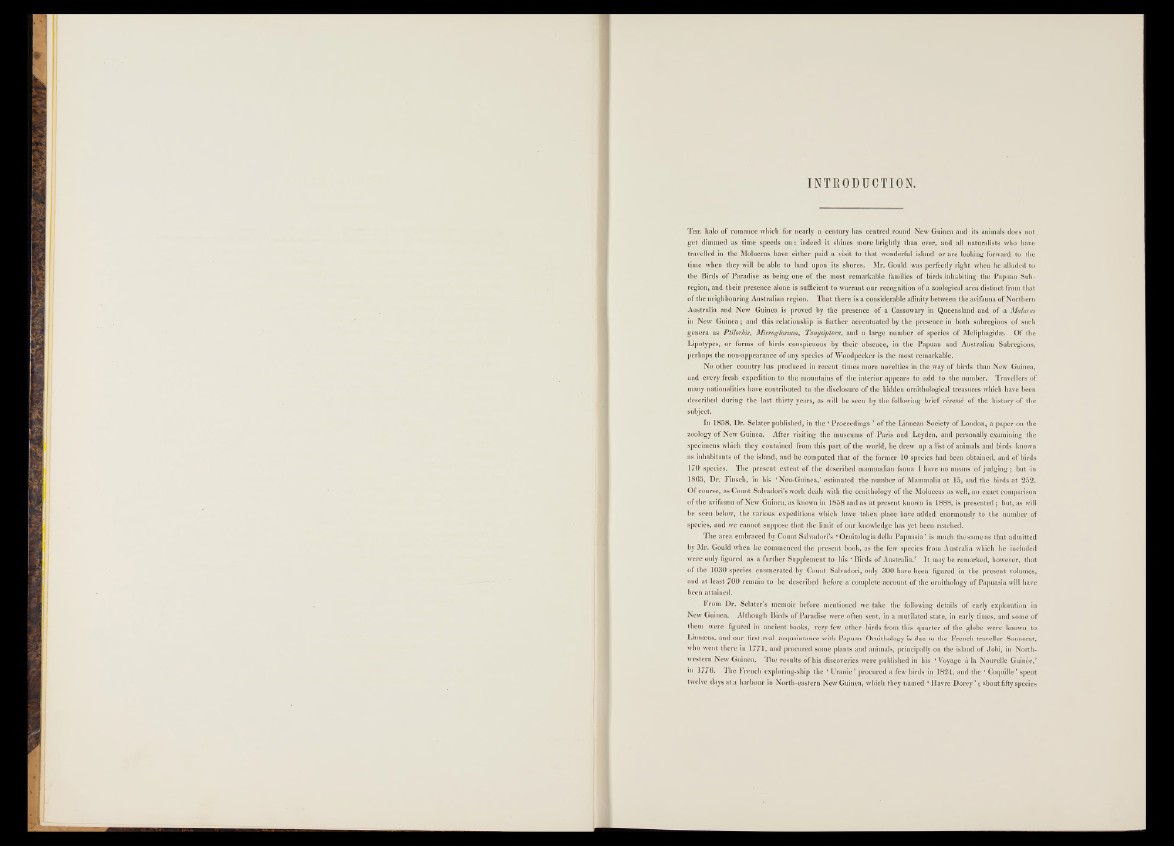
INTRODUCTION.
T h e halo o f romance which for nearly a century has centred round New Guinea and its animals does not
get dimmed as time speeds o n : indeed it shines more brightly than ever, and all naturalists who have
travelled in the Moluccas have either paid a visit to that wonderful island or are looking forward to the
time when they will be able to land upon its shores. Mr. Gould was perfectly right when he alluded to
the Birds o f Paradise as being one of the most remarkable families o f birds inhabiting the Papuan Sub-
region, and their presence alone is sufficient to warrant our recognition o f a zoological area distinct from that
o f the neighbouring Australian region. That there is a considerable affinity between the avifauna o f Northern
Australia and New Guinea is proved by the presence o f a Cassowary in Queensland and o f a Malurus
in New Guinea; and this relationship is further accentuated by the presence in both subregions o f such
genera as Ptilorhis, Microglossum, Tanysiptera, and a large number o f species o f Meliphagidte. Of the
Lipotypes, or forms o f birds conspicuous by their absence, in the Papuan and Australian Subregions,
perhaps the non-appearance o f any species o f Woodpecker is the most remarkable.
No other country has produced in recent times more novelties in the way o f birds than New Guinea,
and every fresh expedition to the mountains o f the interior appears to add to the number. Travellers of
many nationalities have contributed to the disclosure o f the hidden ornithological treasures which have been
described during the last thirty years, as will be seen by the following brief résumé o f the history of the
subject.
In 1858, Dr. Sclater published, in the ‘ Proceedings ’ o f the Linnean Society o f London, a paper on the
zoology o f New Guinea. After visiting the museums o f Paris and Leyden, and personally examining the
specimens which they contained from this part o f the world, he drew up a list o f animals and birds known
as inhabitants of the island, and he computed that o f the former 10 species had been obtained, and o f birds
170 species. The present extent o f the described mammalian fauna I have no means of judging; but in
1865, Dr. Finsch, in his ‘ Neu-Guinea,’ estimated the number o f Mammalia at 15, and the birds at 252.
Of course, as Count Salvadori’s work deals with the ornithology o f the Moluccas as well, no exact comparison
o f the avifauna o f New Guinea, as known in 1858 and as at present known in 1888, is presented; but, as will
be seen below, the various expeditions which have taken place have added enormously to the number of
species, and we cannot suppose that the limit o f our knowledge has yet been reached.
The area embraced by Count Salvadori’s ‘ Ornitología della Papnasia’ is much the same as that admitted
by Mr. Gould when he commenced the present book, as the few species from Australia which he included
were only figured as a further Supplement to his ‘ Birds o f Australia.’ It may be remarked, however, that
o f the 1030 species enumerated by Count Salvadori, only 300 have been figured in the present volumes,
and at least 700 remain to be described before a complete account of the ornithology o f Papuasia will have
been attained.
From Dr. Sclater’s memoir before mentioned we take the following details o f early exploration in
New Guinea. Although Birds o f Paradise were often sent, in a mutilated state, in early times, arid some of
them were figured in ancient books, very few other birds from this quarter o f the globe were known to
Linnseus, and our first real acquaintance with Papuan Ornithology is due to the French traveller Sonuerat,
who went there in 1771, and procured some plants and animals, principally on the island o f Jobi, in Northwestern
New Guinea. The results o f his discoveries were published in his ‘Voyage á la Nouvelle Guiñee,’
in 1776. The French exploring-ship the ‘ Uranie’ procured a few birds in 1824, and the ‘ Coquille’ spent
twelve days at a harbour in North-eastern New Guinea, which they named ‘ Havre Dorey ’ ; about fifty species